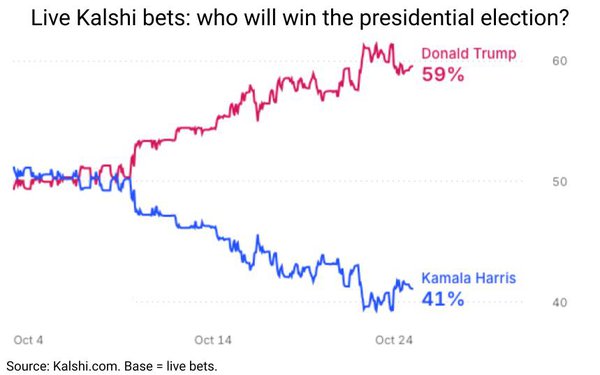
There is big news this month in prediction
markets: a five-year-old market called Kalshi won a suit against the U.S. Commodities Futures Trading Commission (CFTC).
The result of the legal battle is that U.S. residents are now
allowed to trade election contracts in a regulated prediction market.
Since its win, Kalshi has launched several presidential election markets including: “who will win the
election” and “who will win the popular vote?”
Other prediction markets offer election trading, but the dollar amounts are limited.
PredictIt operates under a CFTC waiver, but participants are only able to trade up to $850.
The Iowa Electronic Markets (IEM) isn’t regulated, and it also operates
with a trading limit: $500.
advertisement
advertisement
Polymarket is also a real-money prediction market, but due to laws, it has been off limits to U.S. residents. Considering Kalshi’s recent litigation
success, that could change.
Kalshi is like Polymarket in that it’s well-funded and has big name venture capital backing, including Charles Schwab and Henry Kravis the
co-founder and co-executive chairman of Kohlberg Kravis Roberts.
To date, Kalshi has raised $30.2 million in funding in two rounds, including a pre-seed and a series A. This is
spectacular considering Media Predict struggled to raise a mere $3 million when it was founded.
Here we are just days from the presidential election on Nov. 5th, and prediction
market data are predicting very different election outcomes than other prediction methods, so much so that it’s difficult to know which to believe.
It’s important to note
that there are different types of markets that prediction markets can run. These include markets that predict the probability of an outcome and other markets that predict a number such as a
candidates’ or a party’s share of the vote.
Most of the markets I’ve been analyzing are the former. They’re designed to predict the probability of an
outcome.
IEM offers both types of markets. Its Pres24 VS market predicts popular vote shares for each party and the Pres24 WTA market predicts the probability that one or the other
party will the popular vote.
As of Thursday, IEM’s Pres24 VS market is predicting the popular vote shares to be virtually tied (0.510 for the Democrats and 0.509 for the
Republicans).
Whereas the Pres24 WTA market is predicting an 83.1% chance that the Democrats will win the popular vote versus 13.5% for the Republicans.
My
interpretation of the IEM markets is that they’re predicting the Democrats will win the popular vote by a very small margin.
Kalshi is currently predicting a 59% probability
that Trump will win the election vs. 41% for Harris. However, it’s also predicting a 68% probability that Harris will win the popular vote vs. 32% for Trump.
Polymarket is
reporting results similar to Kalshi with the probability of a Trump win at 62% vs. 38% for Harris. The latter is also predicted to win the popular vote with a 62% probability vs. 38% for Trump.
Polymarket’s Presidential Election Winner 2024 market is currently showing an astonishing $2 billion-plus volume.
The Wall Street Journal reports that
Polymarket’s Trump prediction might have been pushed up by four accounts that made $30 million in collective crypto bets in his favor.
The question is whether the trades were
made to win money or manipulate the market.
The benefit of manipulating the market is to give the impression that votes or donations to Trump wouldn’t be wasted since
he’s predicted to win.
From a prediction perspective, this is a downside to having unlimited prediction market trading. It opens the door for misuse.
PredictIt is also predicting a Trump victory with a 58% Trump probability vs. 47% for Harris.
Except for IEM’s WTA market, these prediction market results fly in the
face of many of the other predictions using alternative methods including the 13 Keys, the Misery Index and the Dow Jones Industrial Average.
All these methods are known to be highly
reliable and are predicting a Harris-led, Democratic Party, victory.
Early voter registration data is also looking favorable for Harris and the Democrats.
An NBC
News analysis of TargetSmart data shows the Democrats leading the Republicans 43% to 39%. As Thursday morning, 26.8 million early votes have been cast.
It’s true that a
voter can be registered for one party and still vote for the other party’s candidate, but people usually vote along party lines.
In states comprising what is known as the
Blue Wall – Pennsylvania, Michigan and Wisconsin -- the democrats are ahead 62% to 29%, 52% to 38% and 42% to 37%, respectively.
Assuming victories in all the non-battleground
blue states she’s expected to have, winning the Blue Wall states would put Harris at the 270 electoral college votes she needs.
The big prediction market money is being bet on
Trump, but the election outcome is by no means a done deal.
If I were a betting man, which I’m not, I would go with IEM and the other prediction methods predicting a Harris
(Democratic) victory. They have proven prediction track records and measured reliability.
Feel free to bet against me, it’s now legal.